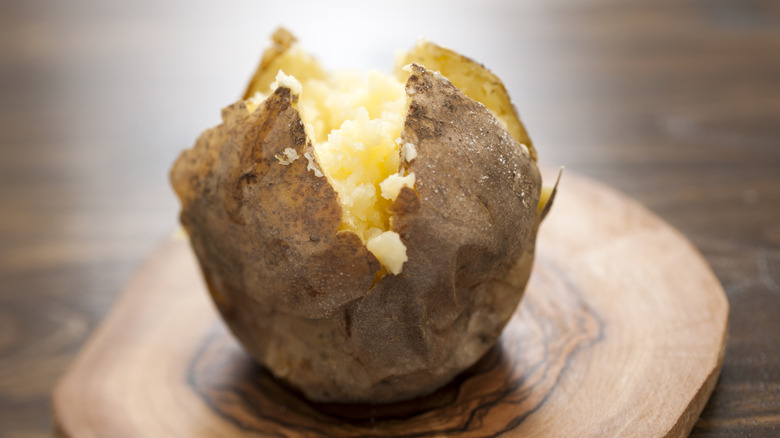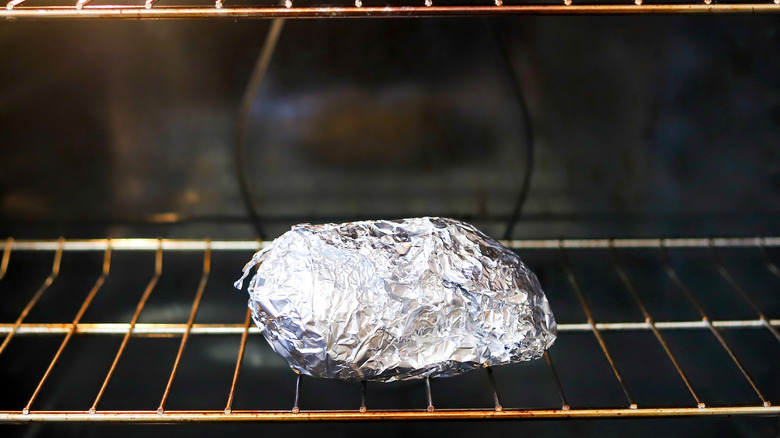The Simple Mistake That Makes Baked Potato Skin Soggy (And How To Fix It)
Someone who's never made a baked potato before would probably assume that you can just stick it in the oven and end up with perfect results. In reality, that's not the case at all. For one, you have to make sure to use the right type of potato. In general, it's best to stick to russet or other starchy potatoes. If you were to use a waxy variety instead, the interior wouldn't become light and fluffy, and the skin would be papery.
Using russet potatoes, however, doesn't necessarily guarantee they'll turn out as expected. Bake the potatoes without poking holes in them first, for example, and one of two things can easily happen: Due to the steam having nowhere to go, the potatoes will either explode in the oven, or turn out gummy and undercooked.
Getting the texture of the skin right is a whole other ordeal. Ideally, it should be crispy, but more often than not it turns out soggy instead. If this is a frequent occurrence when you make baked potatoes, chances are you're being foiled by a common mistake. While your first inclination might be to bake a potato in tin foil, that convenient, thin layer of metal might is spoiling your spuds.
Don't wrap your baked potatoes in aluminum foil
When you first learned how to make a baked potato, you were probably taught to wrap it in foil, and the reason makes perfect sense. Aluminum is a conductor of heat, and that means when you wrap a potato in foil it'll cook faster. Being able to reduce the cooking time is certainly convenient, and as an added plus, the foil keeps the potatoes nice and hot until you're ready to serve them.
The only problem with this method is that it makes the skin soggy. While the foil traps in the heat, allowing it to cook faster, it also traps in moisture. Steam escapes potatoes when they bake, and by covering them in foil, that steam will just sit on the skin. Crispy potato skin is the result of dehydration, and that can't happen with the foil trapping all the moisture in. The inside of the potato may still be perfectly fluffy and delicious, but the skin will never get crispy, leaving you without any of the textural contrast for maximum enjoyment. Lose the foil and you'll be in baked potato heaven.
How to prevent baked potato skin from being soggy
Simply nixing the foil may be the easiest way to prevent baked potato skin from being soggy, but placing the potatoes directly onto a baking tray will cause another mishap. The skin will be crispy, but the bottom will likely be burned or charred by the time the rest of the potato finishes baking. To avoid this, instead place the potatoes right on the oven rack. If you would prefer to use a tray, just make sure the potatoes aren't touching it directly by either putting down a separate rack over the tray, or a bed of kosher salt for the potatoes to lie on.
Hot spots occur when the potato has too much direct contact with heat, so by adding a buffer or removing the tray altogether, the heat is able to circulate. Without any direct heat or steam being used to bake your potatoes, they'll be crispy on the outside with no burned spots.
Once you've mastered the intricacies of potato baking, why not take things to the next level? More than 33,000 posts on Instagram would seem to suggest giving twice-baked potatoes — in which the insides of a baked potato are scooped out and mixed with other ingredients, then returned to the potato skin to be baked once more — a try.


